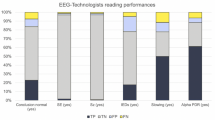Abstract
Quantitative analysis and detection of electroencephalogram (EEG) recordings during evoked activities is essential for clinical diagnosis on neurological disorders. However, the process of interpreting EEG is time consuming for electroencephalographers (EEGers). In this study, an automatic EEG interpretation system constructed in the way of qualified EEGer’s visual inspection was proposed. The system was applied to interpret hyperventilation-induced EEG automatically. The final results of automatic interpretation were compared with EEGer’s visual inspection, and showed high consistence.



Similar content being viewed by others
Explore related subjects
Discover the latest articles and news from researchers in related subjects, suggested using machine learning.References
Deuschl G, Eisen A (1999) Recommendations for the practice of clinical neurophysiology: guidelines of the International Federation of Clinical Neurophysiology, 2nd edn. Electroenceph Clin Neurophysiol (suppl 52):29
Epstein MA, Duchowny M, Jayakar P, Resnick TJ, Alvarez LA (1994) Altered responsiveness during hyperventilation-induced EEG slowing: a non-epileptic phenomenon in normal children. Epilepsia 35:1204–1207
Fukami T, Ishikawa F, Ishikawa B, Saito Y (2008) Quantitative evaluation of photic driving response for computer-aided diagnosis. J Neural Eng 5:411–421
Jin SH, Ham BJ, Kim SY (2005) Functional clustering in EEG photic and auditory driving in schizophrenia. Int J Psychophysiol 56:249–259
Kalayci T, Ozdamar O (1995) Wavelet preprocessing for automated neural network detection of EEG spikes. IEEE Eng Med Biol Mag 14(2):160–166
Nakamura M, Shibasaki H, Imajoh K, Nishida S, Neshige R, Ikeda A (1992) Automatic EEG interpretation: a new computer-assisted system for the automatic integrative interpretation of awake background EEG. Electroenceph Clin Neurophysiol 82:423–431
Nakamura M, Sugi T, Ikeda A, Kakigi R, Shibasaki H (1996) Clinical application of automatic integrative interpretation of awake background EEG: quantitative interpretation, report making, and detection of artifacts and reduced vigilance level. Electroenceph Clin Neurophysiol 98:103–112
Nakamura M, Chen Q, Sugi T, Ikeda A, Shibasaki H (2005) Technical quality evaluation of EEG recording based on electroencephalographers’ knowledge. Med Eng Phys 27:93–100
Oppenheim AV, Schafer RW (1975) Digital signal processing. Prentice-Hall, New Jersey
Park HJ, Oh JS, Jeong DU, Park KS (2000) Automated sleep stage scoring using hybrid rule and case based reasoning. Comput Biomed Res 33(5):330–349
Riddington EP, Ifeachor JWEC, Allen EM, Hudson NR (1996) Intelligent enhancement and interpretation of EEG signals. In: Proceedings of the IEE colloquium on artificial intelligent methods for biomedical data, Savoy Place, London, pp 11/1–11/7
Sugi T, Nakamura M (1997) Quantitative interpretation of posterior dominant rhythm for awake EEG by using combined EEG derivations. Jpn J Med Electron Biol Eng 35(3):272–278 (in Japanese)
Sugi T, Nakamura M, Ikeda A, Shibasaki H (2001) Adaptive EEG spike detection: determination of threshold values based on conditional probability. Front Med Biol Eng 11(4):261–277 (in Japanese)
Acknowledgments
This study is partly supported by National Nature Science Foundation of China 60543005, 60674089; and Shanghai Leading Academic Discipline Project, B504.
Author information
Authors and Affiliations
Corresponding author
Rights and permissions
About this article
Cite this article
Zhang, X., Wang, X., Sugi, T. et al. Automatic interpretation of hyperventilation-induced electroencephalogram constructed in the way of qualified electroencephalographer’s visual inspection. Med Biol Eng Comput 49, 171–180 (2011). https://doi.org/10.1007/s11517-010-0688-9
Received:
Accepted:
Published:
Issue Date:
DOI: https://doi.org/10.1007/s11517-010-0688-9




